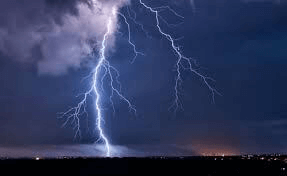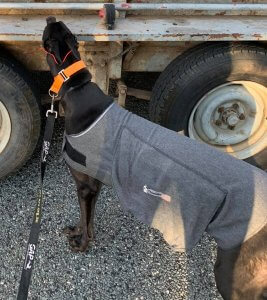
There are a range of adverse weather conditions that can impact on a greyhound’s health and wellbeing. In most cases we think of hot weather over summer that can lead to heat stress or even heat stroke. However, cold weather during the winter months also requires attention to prevent a loss of condition and poor health. Other weather events can also impact on greyhounds at any time of the year. Fire, storms and floods are all events that can happen quickly and it is important to have a plan to respond to these.
On this page you will find:
Greyhounds and storms
Fear of loud noises such as thunderstorms, fireworks or gunshots is quite a common complaint from dog owners of all breeds. The worst times of the year tend to be around New Year’s Eve when there are lots of fireworks, and in spring and summer when significant storms are more likely to occur.
 This can have significant racing implications associated with a greyhound showing signs of distress during storms or loud noises. Fear responses to a thunderstorm the night before a race could derail their whole racing program. Instead of resting, your greyhound is using essential energy as part of the fear response and tiring themselves before they race.
This can have significant racing implications associated with a greyhound showing signs of distress during storms or loud noises. Fear responses to a thunderstorm the night before a race could derail their whole racing program. Instead of resting, your greyhound is using essential energy as part of the fear response and tiring themselves before they race.
It is not uncommon for a greyhound to develop noise phobias as they age. Age-related changes in hearing and/or sight, or in older greyhounds, chronic pain due to arthritis are all thought to affect the way greyhounds respond to sudden loud noises.
For some greyhounds, the fear of loud noises is based on ‘one-event learning’; where the noise has been paired with a very frightening experience, such as something falling on them during a storm. For others, the fear develops gradually with repeated exposure. If you notice your greyhound becoming more sensitive to noises, please seek help!
![]() What you can do to prevent and treat a greyhound developing a noise fear or phobia
What you can do to prevent and treat a greyhound developing a noise fear or phobia
With each exposure to fear-inducing noises, there is the potential for a greyhound to become more fearful. The first step is to look at ways in which the fear-inducing noises can be avoided or exposure to them minimised. The most obvious way to achieve this are to:
-
- move the greyhound away from the sound g. board the greyhound in a different area away from the area where you are – this can be a good idea if you are able to anticipate an event such as fireworks;
- stop the sound occurringwhen the greyhound is nearby (e.g. avoid using power tools, lawn mowers and/or whipper snippers); or
- avoid the situation entirely(e.g. don’t walk your greyhound near busy roads or take your greyhound for a walk when a neighbour is about to mow the lawn or use the whipper snipper).
When it comes to storms, most of the above options are not suitable as you cannot control or avoid the weather. The following options can help to reduce the fear response:
-
- using music, or white noise CD in the kennel block to help dull the sound;
- blocking out light(e.g. covering windows to block out flashes of lightening).
For serious responses to thunderstorms, you should consider creating a safe space for the greyhound within their kennel where they can feel protected. A large crate could be placed inside their kennel covered in blankets and their bed moved into the crate. The door to the crate must be left open, but the dark small space may provide a sense of security and reduce their fear.
If you cannot limit your greyhound’s exposure to the noise to a level that they can cope with and remain calm, then you must seek help from your veterinarian to develop a medication plan. Failure to address noise phobias can derail your entire racing/training program and can result in pups failing to race at all. Remember, medication is not a cure so it is important to combine it with professional advice on behavioural treatments.
![]() Some final tips for dealing with fearful or noise phobic greyhounds
Some final tips for dealing with fearful or noise phobic greyhounds

- Always seek veterinary advice early on if your greyhound is becoming increasingly fearful of loud noises – treatment is more successful if started early.
- Always seek advice from a veterinarian with expertise in dog behaviour for identifying the best options for a phobic greyhound.
- Do not use Acepromazine (ACP) to sedate fearful dogs. This drug sedates the dog but does not stop the dog feeling fearful, which results in an increase in the phobic response over time.
- Thundershirts and Adaptil collars are useful relaxation aids for fearful greyhounds.
- Thundershirts or similar rugs can be used in race day kennels to help calm fearful and anxious greyhounds.
![]() For more information
For more information
There are a range of resources out there to help you. GAP offers a more detailed fact sheet on fear associated with thunderstorms, fireworks and loud noises. You can contact GAP to obtain a copy. In addition, the following resources may be useful:
-
- Thunder phobia in dogsby Patricia McConnell
- PennVet ‘Fear of Thunderstorm and Fireworks’
- ANZCVS Contact list for Veterinary Behaviourists

